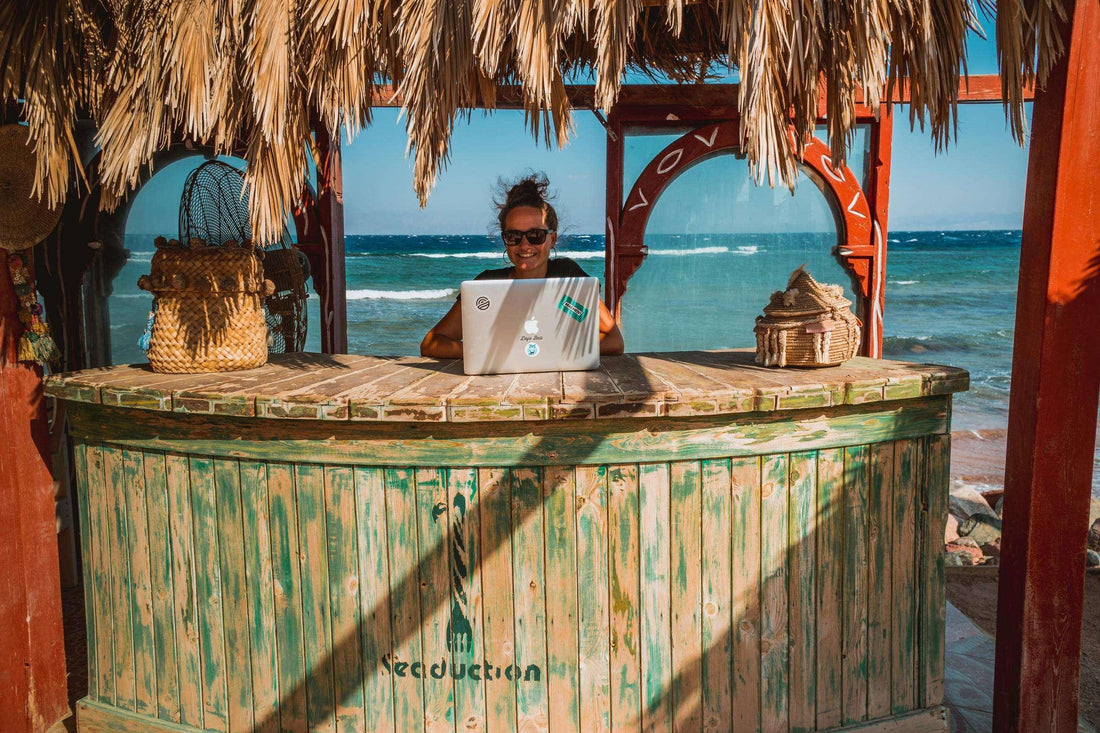Take Your Work on the Road without Going Crazy
Taking your work on the road with you and living a life of perpetual adventure—without giving up a paycheck—is the ultimate dream for many people in 2022. Digital nomadism has become increasingly viable over the last decade, seeing a sharp rise thanks to the pandemic-driven normalization of WFH (work from home). Be warned, however, working as you wander comes with its own unique challenges and potential pitfalls. It is difficult to separate your work and life—let alone balance them!—when everything overlaps and intertwines. And, when your office, home life, creative life, and personal life all inhabit the same space, it is probably the most important thing you can do. The ultimate digital nomad paradox: “I thought freedom would feel freer.”
Working with distributed remote teams, constantly searching for decent wifi, recharging batteries (literal and mental ones), setting strong boundaries—working wherever you want isn’t exactly a carefree endeavor. It is, however, absolutely worth the effort. I have worked as a “digital nomad” for nearly 10 years, since before my mother was reading about the trend in the NY Times and Washington Post. My title has ranged from writer and editor to Head Storyteller, Brand Designer, and the always versatile Consultant. I have worked from a couple dozen different countries and nearly as many time zones, and my “office” has adapted to thousands of cafes, hotels, cars, parks, buses, and short-term rentals.
Over time, I have trial-and-errored my way into a hard-won work-life balance that fits my unique needs. For any current or aspiring digital nomad with a desire to make this lifestyle sustainable, I recommend prioritizing a healthy equilibrium between work, life, and adventure with the Roofnest roof top tents.
Below are my Top 9 Strategies for Finding & Keeping a Solid Work-Life Balance as a Digital Nomad
1. Protect Your Nights & Weekends When I started working remotely, I constantly caught up on extra assignments over the weekend or over dinner, answered emails as soon as I woke up, and generally blurred any sense of boundaries between “work time” and “life time.” I started to burn out, because I rarely had true time off. My life changed dramatically for the better when I started to honor my weekends, ignoring emails and keeping my laptop shut from Friday night until Monday morning. Of course, a benefit of being a digital nomad is (often) getting to set your own hours. If you like to work at night or prefer to work Saturday but take Monday off, go ahead! The point is to delineate clear work hours and off hours, and then to stand by them. Resist the temptation to check in at midnight; unless you work in the ER, it can probably wait until morning.
2. Keep Work Off Your Phone & Social Networks While not an option for everyone (I see you, community managers and influencers), many digital nomads can choose to keep all professional communications (work email, task management apps, Zoom meetings, etc.) to one device only. When I had Slack and work emails set up on my phone, I just had to check the notifications when they came in. This made strategy #1 tricky. The beauty and danger of working in the Digital Age is that we have everything at our fingertips, always. Maybe we don’t need to. When you keep work communications on your laptop (and off your phone), you make a conscious decision to start working when you start up—and stop when you shut down.
3. Get Buy-In If remote work is not yet the norm in your workplace, your first step to freedom may be getting the green light to work from home, if not from the other side of the world. If you are a freelancer, you will have more mobility, but less stability. It is often a trade-off. Have a candid conversation with your employer or clients about the pluses and minuses of taking your work on the road with you, and seek an agreement that makes all parties feel comfortable, adding rather than detracting value for everyone. While perhaps less glamorous than quitting your job, selling your house, and hitting the road, in the long-run a measured approach to going nomadic with buy-in from your employer could result in a far more sustainable outcome.
4. Figure Out Your Optimal Work Conditions If, like me, you like to be surrounded by activity to buckle down and focus, cafes, restaurants, beach bars, or hotel lobbies may be an ideal setting for your Office of the Day. Just about wherever you find yourself, there is likely to be at least a coffee shack or bar with a sketchy wifi connection nearby. If silence and serenity motivate you more, then libraries, co-working spaces, the inside of your Condor Overland 2 XL Air, or a nice rock in the woods (connectivity allowing) may suit you better. Do you like music, or ambient chatter? A comfortable chair, or a place to set up your standing desk? Friendly faces, or solitude? Figure out what work conditions make you most productive (more productive means more time for adventure), and then do what you can to make that happen while you’re on the road. You may occasionally need to plan your itinerary around it.
5. Be Practical About The Practical Things Most digital nomads will need a few basic things to get work done: relevant technology (a laptop, maybe a camera, headphones, or recording tools), a power source, an internet connection, food and water, sleep. Those last two are on you. When it comes to fundamentals like internet and power, I encourage you to avoid the mistakes I have made and become as self-sufficient as you can. What does that mean? Buy yourself a power bank that you always keep charged. Solar is even better. Make sure you have a local SIM card and plenty of data so you can make yourself a hotspot when wifi inevitably disappoints. Have whatever devices, software, tech you need to do your work efficiently. Cover your bases with the basics, and you will spare yourself countless hours of exasperation over slow wifi, dead batteries, and tech breakdowns. Plus, consider protecting your tent with quality tent covers while you power through your journey.
6. Get Your Time Zones Together Nothing kills efficiency like missing meetings because you got the time change mixed up. You would think that with all of modern technology we would have overcome the challenges of time zones by now. To the contrary, it seems to get worse every year. If you are the nomad of the group, it is especially important to get this right. Be available for team calls and check-ins, and make sure you have your time zone conversions on lock. If you love working late nights or early mornings, you might be able to make that happen at a larger distance. For some teams who prioritize ‘round-the-clock operations, a different time zone may even work in your favor. If you want to stay on a normal work schedule, you may need to stick to the same or similar time zone as the people with whom you need to work closely. Keep your time zones straight, and if you can’t, stay in sync with your home office. Good news, though: the world is very long. There are a wide variety of destinations to be discovered in just about every time zone.
7. Take Real Vacations It may seem extraneous to take a vacation when your life is a never-ending adventure, but this is actually another key safeguard against burnout. Being constantly plugged in is draining, and hardly sustainable in the long-term. I recommend marking off chunks of time (longer than a weekend) to truly unplug and enjoy whichever glorious place you are calling Home For Now. How much time? That will be a negotiation between what you can afford and what your mind and body demand. Consider scheduling your off time the same way you might schedule a work meeting. Give your life the same weight and priority on your calendar as your work. It can go a long way towards achieving that elusive balance. Taking a vacation from your ongoing “vacation” sounds indulgent, but it’s not. Give yourself the time and space you need to fully rest and recharge, perhaps equipped with one of the Puffy Camp Blankets for cozy downtime.
8. Try on Non-Attachment For Size The best-laid plans and all that. You can do everything right, and even so some days will not go your way. Road closures, dead zones, power outages, irresistible adventures, and the unavoidable crises of life and travel will miss you meetings and deadlines. You can try to plan in advance, work ahead, manage expectations, and promise only what you can deliver (and you should)—and still, sometimes something will go awry. In those moments, ride the wave of anxiety, let go of perfectionism, and allow things to be as they are, not as you wish they would be. In a nutshell, some degree of non-attachment is a necessary complement to all the other strategies in your digital nomad toolkit. Chaos, small messes, major crises—these are all part of the bargain, but the adventure is worth all of it. In fact, maybe the adventure depends on it.
9. Honor the Privilege In my first fully-digital jobs, my employer opted not to give me a raise after my first year. Their reasoning? I didn’t seem seriously committed to the job, because I moved around so much. The fact that I was highly productive, always on time, and deeply committed to the mission didn’t seem to register against my unconventional lifestyle. That was many years ago, but unfortunately many employers still look askance at digital nomadism. As a digital nomad, you have to work harder and more productively to prove that your lifestyle is not an obstacle to getting the job done. “Just as hard” isn’t enough. Remember that being a location-independent contractor or employee is a privilege, and one we must continually earn. Whatever the norm is in your workplace for accountability, responsiveness, and attentiveness, go above and beyond that. Honor the extra responsibility that comes with exceptional freedom. Digital nomads, what do you think? What strategies would you add to the list? Will you bring your work (and of course your Falcon 3 EVO Air) with you for your next adventure? Happy travels!




